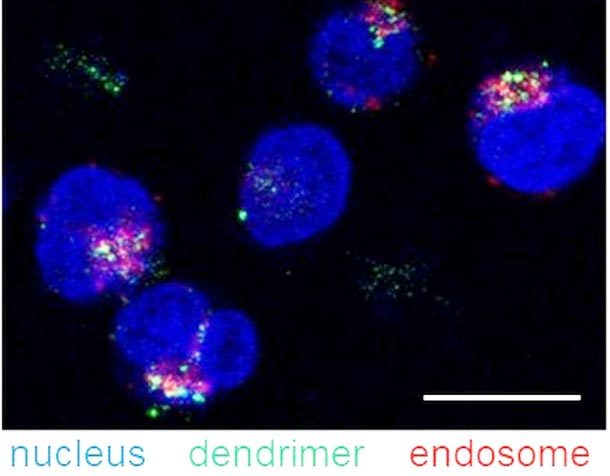A novel nanoplatform for delivering drugs into lymphocytes

Detailed microscopic imaging showing the intracellular distribution of carboxy-terminal Phe- and CHex-modified dendrimers into T cells.
Credit: Chie Kojima, Osaka Prefecture University
A pH-sensitive drug delivery system in T cells using C-terminal dendrimers with Phenylalanine.
T cells, also known as lymphocytes, have important roles in various immune reactions. However, there are only a few reports on delivery systems into T cells. Realizing this, it is essential to work and actively contribute in controlling immune systems.
Associate Professor Chie Kojima and her co-workers from Department of Applied Chemistry, Graduate School of Engineering, Osaka Prefecture University (OPU), collaborating with Professor Ikuo Fujii and Ikuhiko Nakase from Department of Biological Science, Graduate School of Science, OPU, have performed an experimental study constructing a pH-sensitive delivery system into T cells and their subsets by using carboxy-terminal dendrimers (highly ordered, branched polymeric molecules) bearing phenylalanine (Phe) and hydrophobic acid anhydride (cyclohexanedicarboxylic anhydride, CHex), such as PAMAM-CHex-Phe and PAMAM-Phe-CHex. These dendrimers showed a higher association with splenocyte-derived T cells, which suggests that the hydrophobic effect significantly influences the association of dendrimers with immune cells.
The T cell association of these dendrimers was examined at different pH and temperatures using fluorescence-activated cell sorting, where murine splenocytes stained with an anti-CD3 antibody were used. Along with this, the association of PAMAM-CHex-Phe and PAMAM-Phe-CHex with some culture cell lines and T cell subsets, such as CD4-positive helper T cells (CD3+CD4+), CD8- positive killer T cells (CD3+CD8+) and activated T cells (CD3+CD69+) was also examined. In order to confirm the internalization of these dendrimers into T cells, Assoc. Prof. Kojima and her co-workers used confocal microscopic imaging, as shown in Figure 1, to observe the intracellular distribution of PAMAM-CHex-Phe and PAMAM-Phe-CHex.
Assoc. Prof. Kojima mentions, “Although T cells play important roles in various immune reactions, there are only a few reports on delivery systems into T cells. In this study, we applied the Phe-modified dendrimers to a pH-sensitive drug delivery system into T cells. Dendrimers with different amino acids and acid anhydrides were synthesized, and their pH-responsive association with T cells and their subsets was investigated.”
This experimental study by Assoc. Prof. Kojima and her co-workers has successfully presented the findings in terms of a) Synthesis and pH sensitivity of the carboxy-terminal dendrimers bearing Phe; b) pH-responsive association of the carboxy-terminal dendrimers bearing Phe with T cells and T cell subsets including activated T cells; c) Internalization of PAMAM-Phe-CHex and PAMAM-CHex-Phe into T cells.
She concludes, “Our results showed that Phe- and CHex-modified dendrimers have a delivery potential to T cells and their subsets. This will play a key role in cancer immunotherapy”.
Activation of lymph node-resident helper T cells and killer T cells as well as suppression of regulatory T cells localized in tumor tissues is necessary in cancer immunotherapy. Hence, based on the pH-responsive properties, the findings (dendrimers) obtained by Assoc. Prof. Kojima and her co-workers are important for the development of nanoplatforms for direct delivery to T cells to control the functions of T cells, which are useful for cancer immunotherapy.
The article “Carboxy-terminal dendrimers with phenylalanine for a pH-sensitive delivery system into immune cells, including T cells” was published on December 7, 2021 in the Journal of Materials Chemistry B.
In addition, these findings also build upon the following previously published article:
“Association of Hydrophobic Carboxyl-Terminal Dendrimers with Lymph Node-Resident Lymphocytes”
About Osaka Prefecture University, Japan
Osaka Prefecture University (OPU) is one of the largest public universities in Japan.
OPU comprises three campuses, with a main campus in Sakai, Osaka. With four colleges for undergraduate students and seven graduate schools, the university offers stellar education in a myriad of fields like engineering, life and environmental sciences, science, economics, humanities and social sciences, and nursing. Not just this, the university also houses various international students, who can enrich their lives with opportunities for internships and exchange programs.
In April 2022, OPU will unite with Osaka City University (OCU) to form Japan’s largest public university, Osaka Metropolitan University.
For more details, please visit:
Osaka Prefecture University (OPU): https://www.osakafu-u.ac.jp/en
Osaka Metropolitan University (OMU): https://www.upc-osaka.ac.jp/new-univ/en-research/
Journal: Journal of Materials Chemistry B DOI: 10.1039/D1TB01980E Method of Research: Experimental study Subject of Research: Animal tissue samples Article Title: Carboxy-terminal dendrimers with phenylalanine for a pH-sensitive delivery system into immune cells including T cells Article Publication Date: 7-Dec-2021
Media Contact
Yoshiko Tani
Osaka Prefecture University
yoshiko.tani@ao.osakafu-u.ac.jp
Office: 81-722-549-103
Original Source
All latest news from the category: Life Sciences and Chemistry
Articles and reports from the Life Sciences and chemistry area deal with applied and basic research into modern biology, chemistry and human medicine.
Valuable information can be found on a range of life sciences fields including bacteriology, biochemistry, bionics, bioinformatics, biophysics, biotechnology, genetics, geobotany, human biology, marine biology, microbiology, molecular biology, cellular biology, zoology, bioinorganic chemistry, microchemistry and environmental chemistry.
Newest articles

Webb captures top of iconic horsehead nebula in unprecedented detail
NASA’s James Webb Space Telescope has captured the sharpest infrared images to date of a zoomed-in portion of one of the most distinctive objects in our skies, the Horsehead Nebula….

Cost-effective, high-capacity, and cyclable lithium-ion battery cathodes
Charge-recharge cycling of lithium-superrich iron oxide, a cost-effective and high-capacity cathode for new-generation lithium-ion batteries, can be greatly improved by doping with readily available mineral elements. The energy capacity and…

Novel genetic plant regeneration approach
…without the application of phytohormones. Researchers develop a novel plant regeneration approach by modulating the expression of genes that control plant cell differentiation. For ages now, plants have been the…





















